Report on Developing Manager: Leadership, Skills & Career Growth
VerifiedAdded on 2024/06/07
|24
|4889
|392
Report
AI Summary
This report explores the methods and styles of a developing manager within the field of management, discussing principles and practices of management behavior. Task 1 compares different management styles, analyzes leadership characteristics, evaluates communication processes, and examines organizational culture in selected businesses. Task 2 assesses management skills, analyzes personal strengths, weaknesses, opportunities, and threats (SWOT), and prioritizes objectives for personal development. Task 3 focuses on leading and motivating a team to achieve goals and justifying managerial decisions. Finally, Task 4 explains how managerial and personal skills support career development and reviews career needs to produce a development plan. The report uses examples from Thomas Cook and TUI to illustrate management styles and communication processes, highlighting the importance of adaptability and strategic decision-making in achieving organizational objectives. This student contributed assignment is available on Desklib, where students can find various study resources.
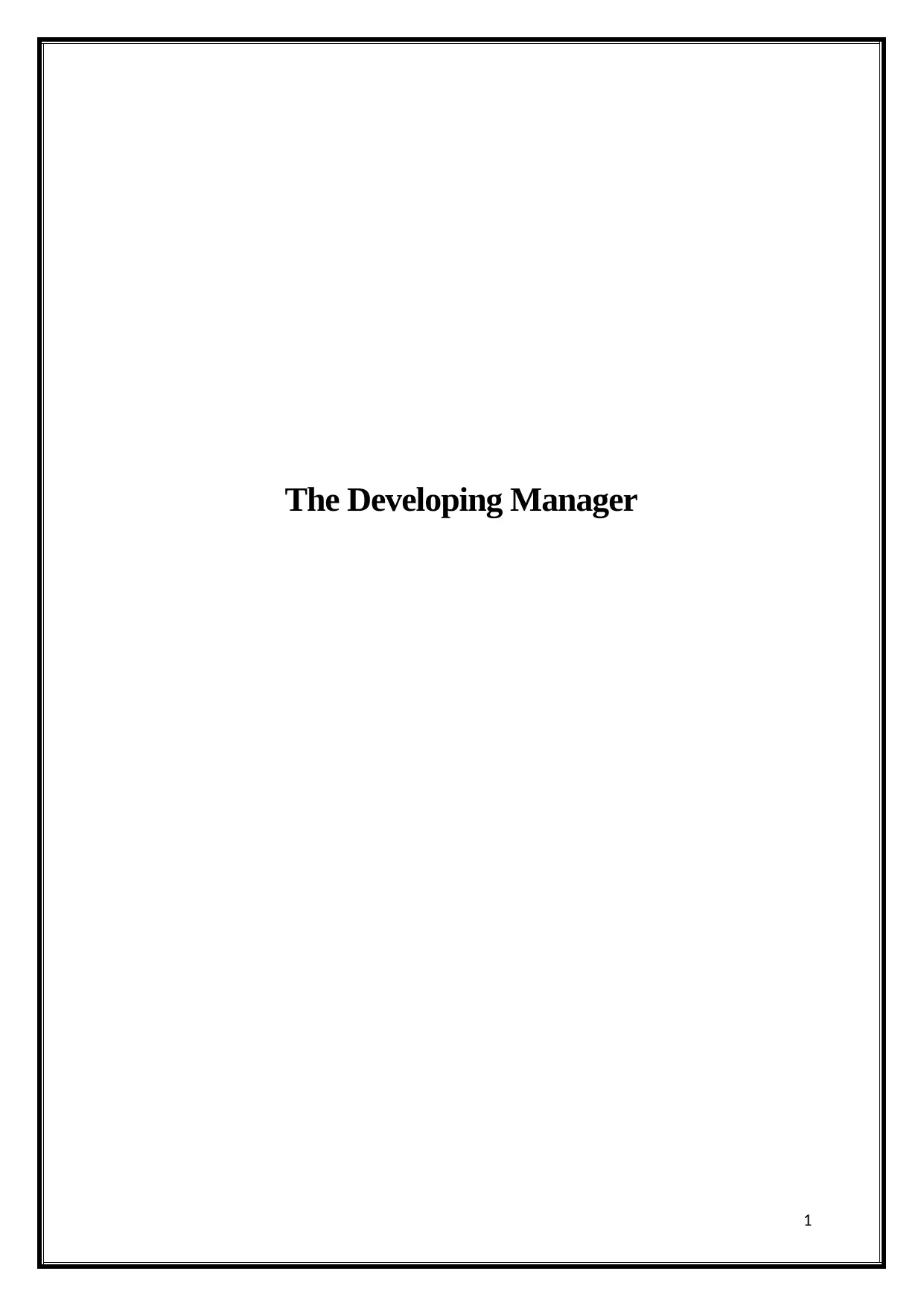
The Developing Manager
1
1
Paraphrase This Document
Need a fresh take? Get an instant paraphrase of this document with our AI Paraphraser
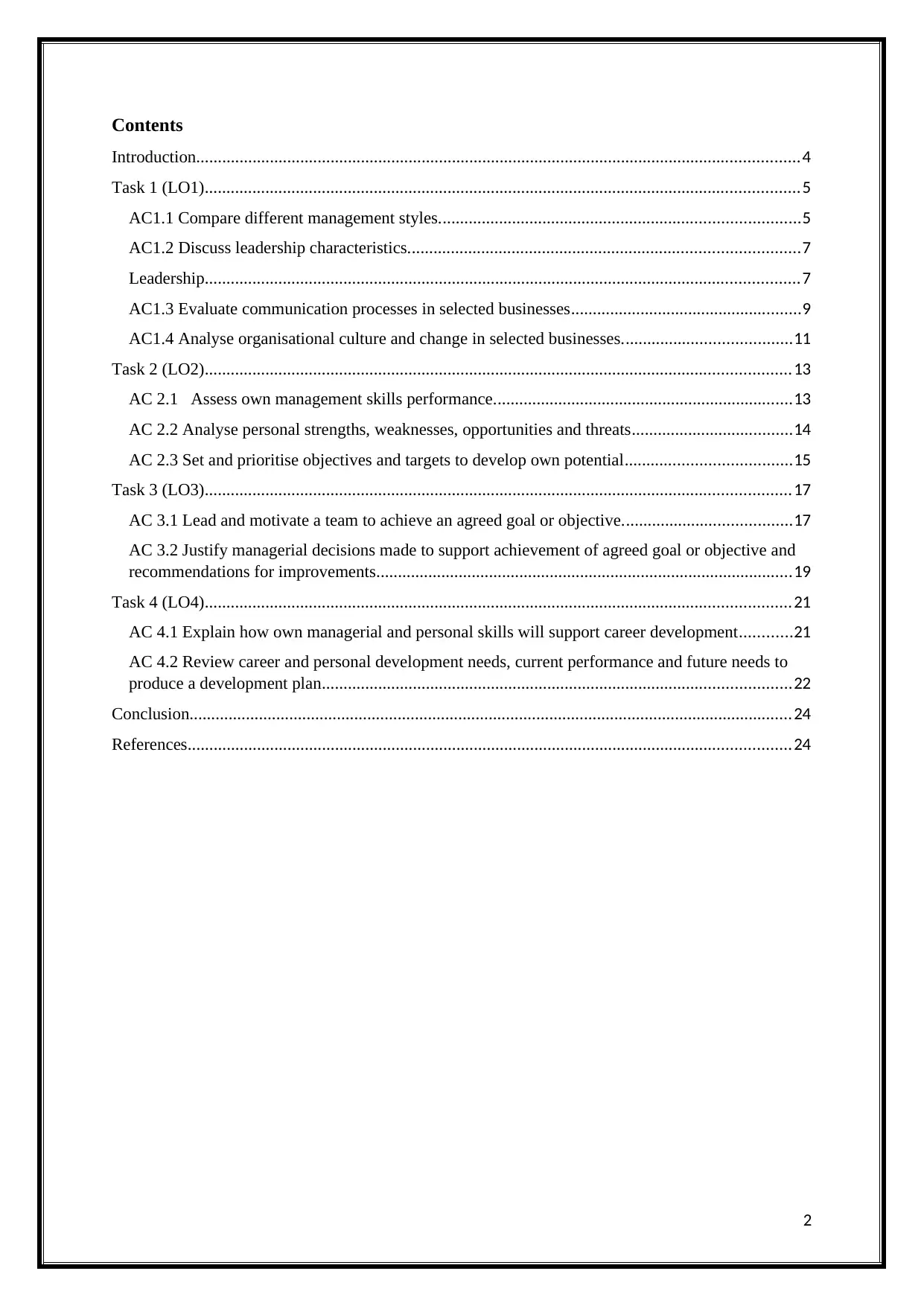
Contents
Introduction...........................................................................................................................................4
Task 1 (LO1).........................................................................................................................................5
AC1.1 Compare different management styles...................................................................................5
AC1.2 Discuss leadership characteristics..........................................................................................7
Leadership.........................................................................................................................................7
AC1.3 Evaluate communication processes in selected businesses.....................................................9
AC1.4 Analyse organisational culture and change in selected businesses.......................................11
Task 2 (LO2).......................................................................................................................................13
AC 2.1 Assess own management skills performance.....................................................................13
AC 2.2 Analyse personal strengths, weaknesses, opportunities and threats.....................................14
AC 2.3 Set and prioritise objectives and targets to develop own potential......................................15
Task 3 (LO3).......................................................................................................................................17
AC 3.1 Lead and motivate a team to achieve an agreed goal or objective.......................................17
AC 3.2 Justify managerial decisions made to support achievement of agreed goal or objective and
recommendations for improvements................................................................................................19
Task 4 (LO4).......................................................................................................................................21
AC 4.1 Explain how own managerial and personal skills will support career development............21
AC 4.2 Review career and personal development needs, current performance and future needs to
produce a development plan............................................................................................................22
Conclusion...........................................................................................................................................24
References...........................................................................................................................................24
2
Introduction...........................................................................................................................................4
Task 1 (LO1).........................................................................................................................................5
AC1.1 Compare different management styles...................................................................................5
AC1.2 Discuss leadership characteristics..........................................................................................7
Leadership.........................................................................................................................................7
AC1.3 Evaluate communication processes in selected businesses.....................................................9
AC1.4 Analyse organisational culture and change in selected businesses.......................................11
Task 2 (LO2).......................................................................................................................................13
AC 2.1 Assess own management skills performance.....................................................................13
AC 2.2 Analyse personal strengths, weaknesses, opportunities and threats.....................................14
AC 2.3 Set and prioritise objectives and targets to develop own potential......................................15
Task 3 (LO3).......................................................................................................................................17
AC 3.1 Lead and motivate a team to achieve an agreed goal or objective.......................................17
AC 3.2 Justify managerial decisions made to support achievement of agreed goal or objective and
recommendations for improvements................................................................................................19
Task 4 (LO4).......................................................................................................................................21
AC 4.1 Explain how own managerial and personal skills will support career development............21
AC 4.2 Review career and personal development needs, current performance and future needs to
produce a development plan............................................................................................................22
Conclusion...........................................................................................................................................24
References...........................................................................................................................................24
2
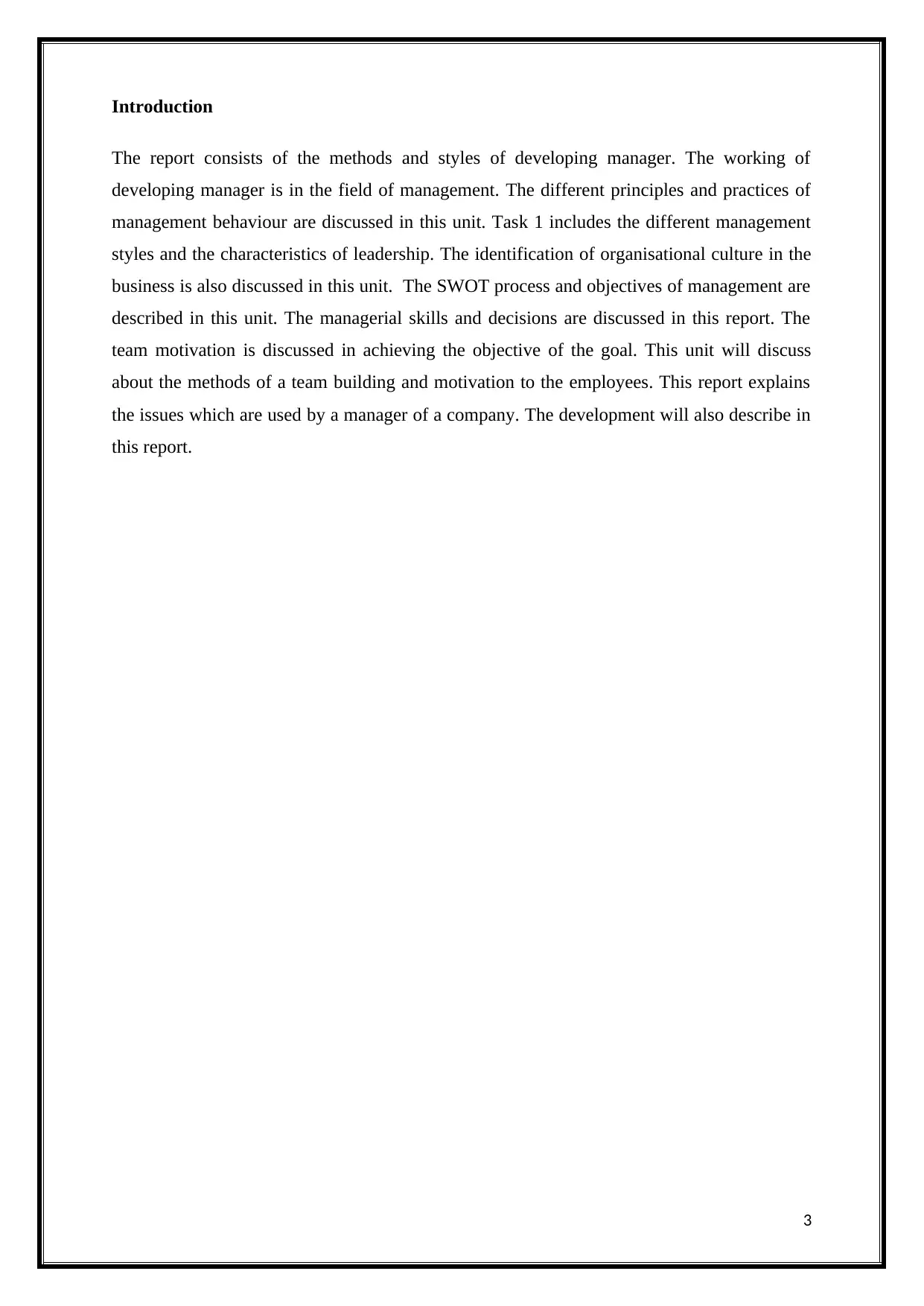
Introduction
The report consists of the methods and styles of developing manager. The working of
developing manager is in the field of management. The different principles and practices of
management behaviour are discussed in this unit. Task 1 includes the different management
styles and the characteristics of leadership. The identification of organisational culture in the
business is also discussed in this unit. The SWOT process and objectives of management are
described in this unit. The managerial skills and decisions are discussed in this report. The
team motivation is discussed in achieving the objective of the goal. This unit will discuss
about the methods of a team building and motivation to the employees. This report explains
the issues which are used by a manager of a company. The development will also describe in
this report.
3
The report consists of the methods and styles of developing manager. The working of
developing manager is in the field of management. The different principles and practices of
management behaviour are discussed in this unit. Task 1 includes the different management
styles and the characteristics of leadership. The identification of organisational culture in the
business is also discussed in this unit. The SWOT process and objectives of management are
described in this unit. The managerial skills and decisions are discussed in this report. The
team motivation is discussed in achieving the objective of the goal. This unit will discuss
about the methods of a team building and motivation to the employees. This report explains
the issues which are used by a manager of a company. The development will also describe in
this report.
3
⊘ This is a preview!⊘
Do you want full access?
Subscribe today to unlock all pages.

Trusted by 1+ million students worldwide
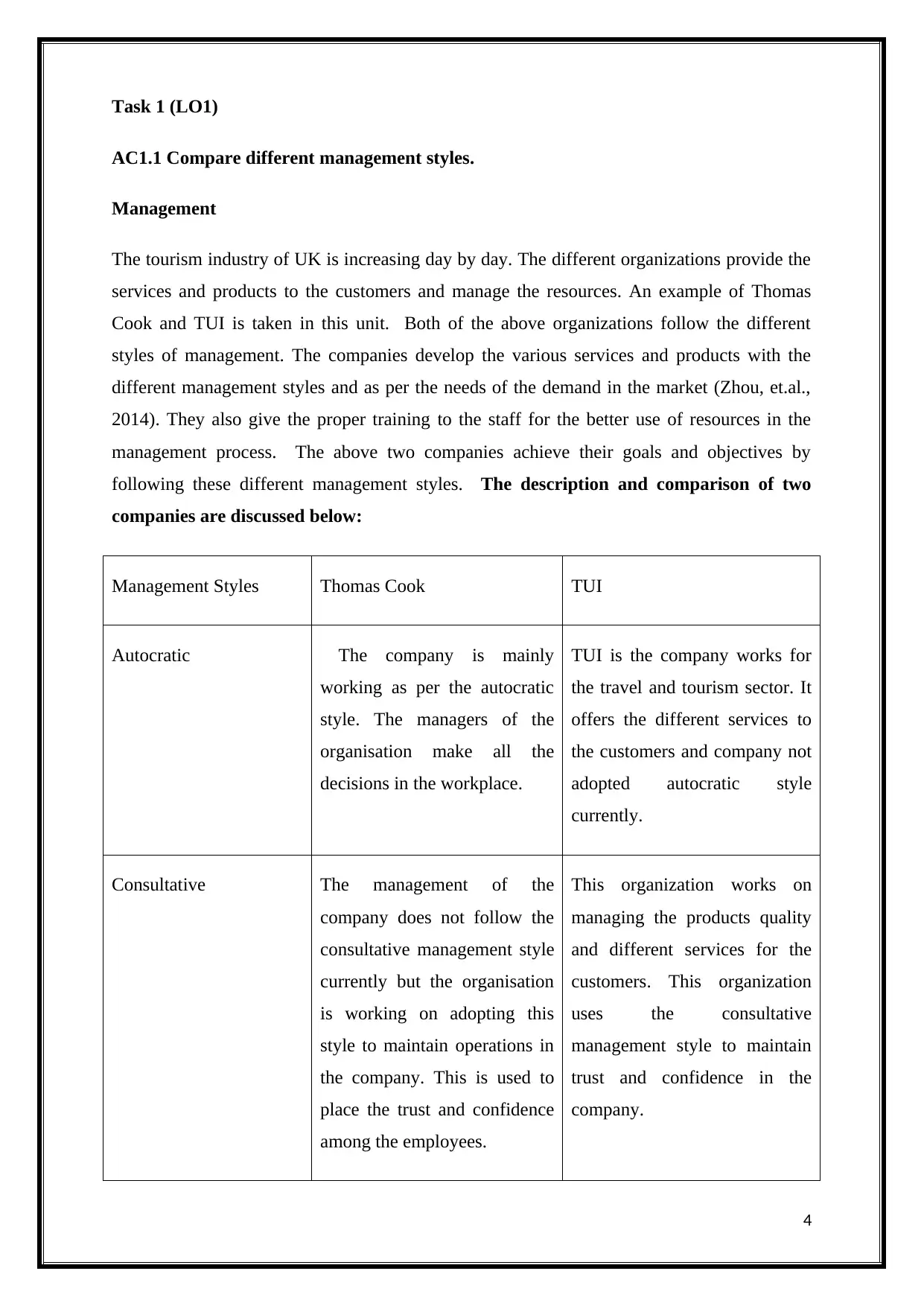
Task 1 (LO1)
AC1.1 Compare different management styles.
Management
The tourism industry of UK is increasing day by day. The different organizations provide the
services and products to the customers and manage the resources. An example of Thomas
Cook and TUI is taken in this unit. Both of the above organizations follow the different
styles of management. The companies develop the various services and products with the
different management styles and as per the needs of the demand in the market (Zhou, et.al.,
2014). They also give the proper training to the staff for the better use of resources in the
management process. The above two companies achieve their goals and objectives by
following these different management styles. The description and comparison of two
companies are discussed below:
Management Styles Thomas Cook TUI
Autocratic The company is mainly
working as per the autocratic
style. The managers of the
organisation make all the
decisions in the workplace.
TUI is the company works for
the travel and tourism sector. It
offers the different services to
the customers and company not
adopted autocratic style
currently.
Consultative The management of the
company does not follow the
consultative management style
currently but the organisation
is working on adopting this
style to maintain operations in
the company. This is used to
place the trust and confidence
among the employees.
This organization works on
managing the products quality
and different services for the
customers. This organization
uses the consultative
management style to maintain
trust and confidence in the
company.
4
AC1.1 Compare different management styles.
Management
The tourism industry of UK is increasing day by day. The different organizations provide the
services and products to the customers and manage the resources. An example of Thomas
Cook and TUI is taken in this unit. Both of the above organizations follow the different
styles of management. The companies develop the various services and products with the
different management styles and as per the needs of the demand in the market (Zhou, et.al.,
2014). They also give the proper training to the staff for the better use of resources in the
management process. The above two companies achieve their goals and objectives by
following these different management styles. The description and comparison of two
companies are discussed below:
Management Styles Thomas Cook TUI
Autocratic The company is mainly
working as per the autocratic
style. The managers of the
organisation make all the
decisions in the workplace.
TUI is the company works for
the travel and tourism sector. It
offers the different services to
the customers and company not
adopted autocratic style
currently.
Consultative The management of the
company does not follow the
consultative management style
currently but the organisation
is working on adopting this
style to maintain operations in
the company. This is used to
place the trust and confidence
among the employees.
This organization works on
managing the products quality
and different services for the
customers. This organization
uses the consultative
management style to maintain
trust and confidence in the
company.
4
Paraphrase This Document
Need a fresh take? Get an instant paraphrase of this document with our AI Paraphraser
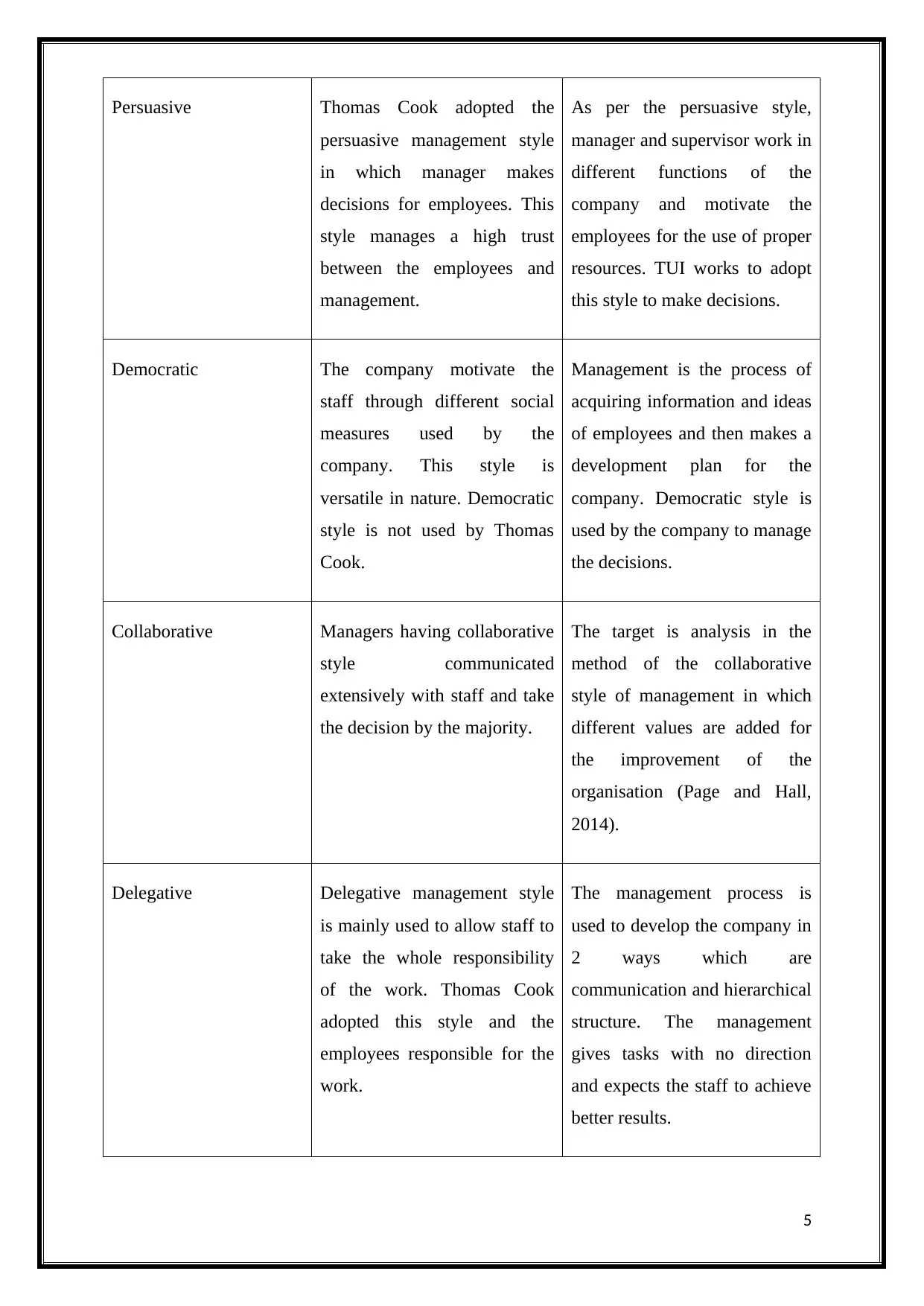
Persuasive Thomas Cook adopted the
persuasive management style
in which manager makes
decisions for employees. This
style manages a high trust
between the employees and
management.
As per the persuasive style,
manager and supervisor work in
different functions of the
company and motivate the
employees for the use of proper
resources. TUI works to adopt
this style to make decisions.
Democratic The company motivate the
staff through different social
measures used by the
company. This style is
versatile in nature. Democratic
style is not used by Thomas
Cook.
Management is the process of
acquiring information and ideas
of employees and then makes a
development plan for the
company. Democratic style is
used by the company to manage
the decisions.
Collaborative Managers having collaborative
style communicated
extensively with staff and take
the decision by the majority.
The target is analysis in the
method of the collaborative
style of management in which
different values are added for
the improvement of the
organisation (Page and Hall,
2014).
Delegative Delegative management style
is mainly used to allow staff to
take the whole responsibility
of the work. Thomas Cook
adopted this style and the
employees responsible for the
work.
The management process is
used to develop the company in
2 ways which are
communication and hierarchical
structure. The management
gives tasks with no direction
and expects the staff to achieve
better results.
5
persuasive management style
in which manager makes
decisions for employees. This
style manages a high trust
between the employees and
management.
As per the persuasive style,
manager and supervisor work in
different functions of the
company and motivate the
employees for the use of proper
resources. TUI works to adopt
this style to make decisions.
Democratic The company motivate the
staff through different social
measures used by the
company. This style is
versatile in nature. Democratic
style is not used by Thomas
Cook.
Management is the process of
acquiring information and ideas
of employees and then makes a
development plan for the
company. Democratic style is
used by the company to manage
the decisions.
Collaborative Managers having collaborative
style communicated
extensively with staff and take
the decision by the majority.
The target is analysis in the
method of the collaborative
style of management in which
different values are added for
the improvement of the
organisation (Page and Hall,
2014).
Delegative Delegative management style
is mainly used to allow staff to
take the whole responsibility
of the work. Thomas Cook
adopted this style and the
employees responsible for the
work.
The management process is
used to develop the company in
2 ways which are
communication and hierarchical
structure. The management
gives tasks with no direction
and expects the staff to achieve
better results.
5
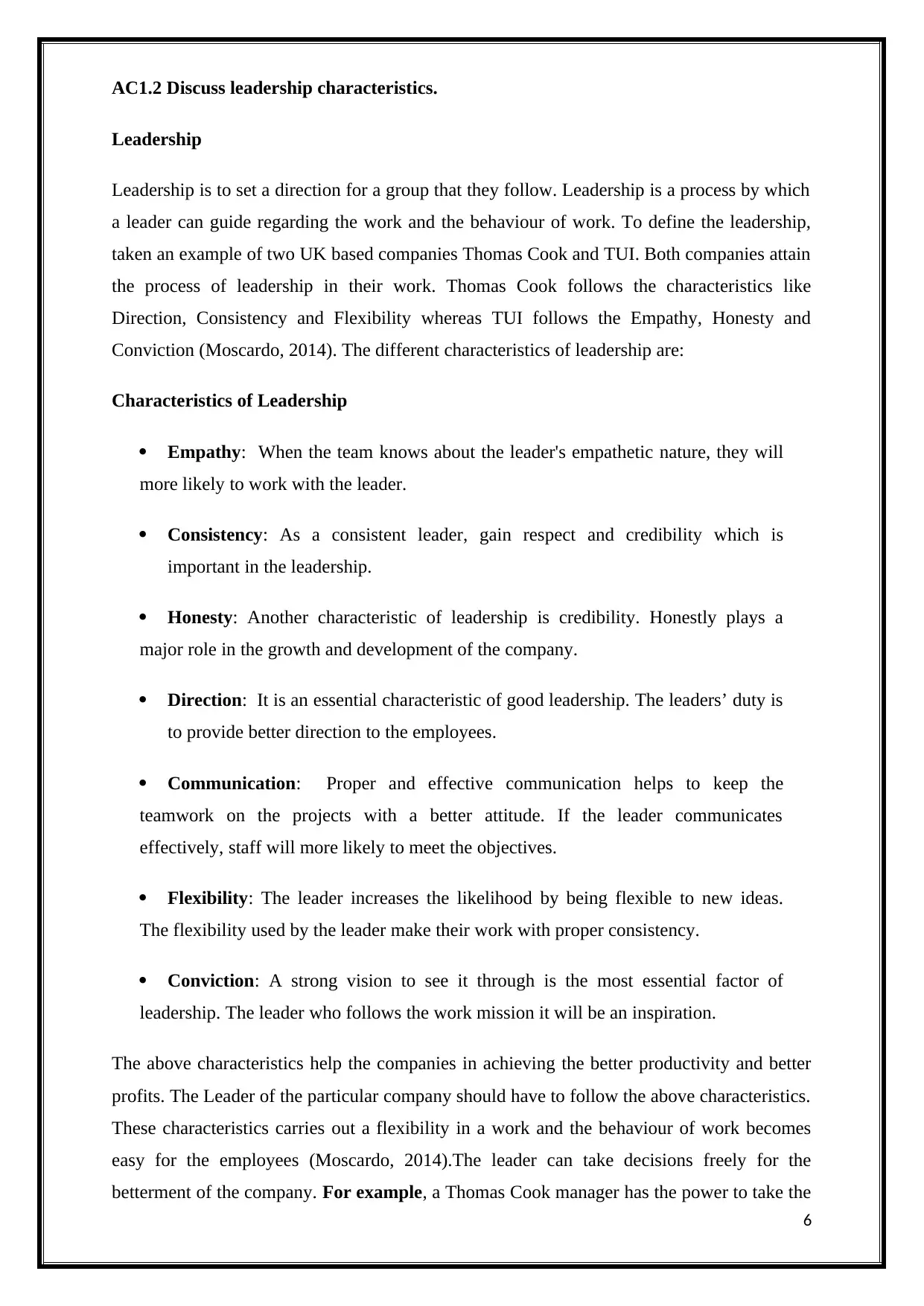
AC1.2 Discuss leadership characteristics.
Leadership
Leadership is to set a direction for a group that they follow. Leadership is a process by which
a leader can guide regarding the work and the behaviour of work. To define the leadership,
taken an example of two UK based companies Thomas Cook and TUI. Both companies attain
the process of leadership in their work. Thomas Cook follows the characteristics like
Direction, Consistency and Flexibility whereas TUI follows the Empathy, Honesty and
Conviction (Moscardo, 2014). The different characteristics of leadership are:
Characteristics of Leadership
Empathy: When the team knows about the leader's empathetic nature, they will
more likely to work with the leader.
Consistency: As a consistent leader, gain respect and credibility which is
important in the leadership.
Honesty: Another characteristic of leadership is credibility. Honestly plays a
major role in the growth and development of the company.
Direction: It is an essential characteristic of good leadership. The leaders’ duty is
to provide better direction to the employees.
Communication: Proper and effective communication helps to keep the
teamwork on the projects with a better attitude. If the leader communicates
effectively, staff will more likely to meet the objectives.
Flexibility: The leader increases the likelihood by being flexible to new ideas.
The flexibility used by the leader make their work with proper consistency.
Conviction: A strong vision to see it through is the most essential factor of
leadership. The leader who follows the work mission it will be an inspiration.
The above characteristics help the companies in achieving the better productivity and better
profits. The Leader of the particular company should have to follow the above characteristics.
These characteristics carries out a flexibility in a work and the behaviour of work becomes
easy for the employees (Moscardo, 2014).The leader can take decisions freely for the
betterment of the company. For example, a Thomas Cook manager has the power to take the
6
Leadership
Leadership is to set a direction for a group that they follow. Leadership is a process by which
a leader can guide regarding the work and the behaviour of work. To define the leadership,
taken an example of two UK based companies Thomas Cook and TUI. Both companies attain
the process of leadership in their work. Thomas Cook follows the characteristics like
Direction, Consistency and Flexibility whereas TUI follows the Empathy, Honesty and
Conviction (Moscardo, 2014). The different characteristics of leadership are:
Characteristics of Leadership
Empathy: When the team knows about the leader's empathetic nature, they will
more likely to work with the leader.
Consistency: As a consistent leader, gain respect and credibility which is
important in the leadership.
Honesty: Another characteristic of leadership is credibility. Honestly plays a
major role in the growth and development of the company.
Direction: It is an essential characteristic of good leadership. The leaders’ duty is
to provide better direction to the employees.
Communication: Proper and effective communication helps to keep the
teamwork on the projects with a better attitude. If the leader communicates
effectively, staff will more likely to meet the objectives.
Flexibility: The leader increases the likelihood by being flexible to new ideas.
The flexibility used by the leader make their work with proper consistency.
Conviction: A strong vision to see it through is the most essential factor of
leadership. The leader who follows the work mission it will be an inspiration.
The above characteristics help the companies in achieving the better productivity and better
profits. The Leader of the particular company should have to follow the above characteristics.
These characteristics carries out a flexibility in a work and the behaviour of work becomes
easy for the employees (Moscardo, 2014).The leader can take decisions freely for the
betterment of the company. For example, a Thomas Cook manager has the power to take the
6
⊘ This is a preview!⊘
Do you want full access?
Subscribe today to unlock all pages.

Trusted by 1+ million students worldwide
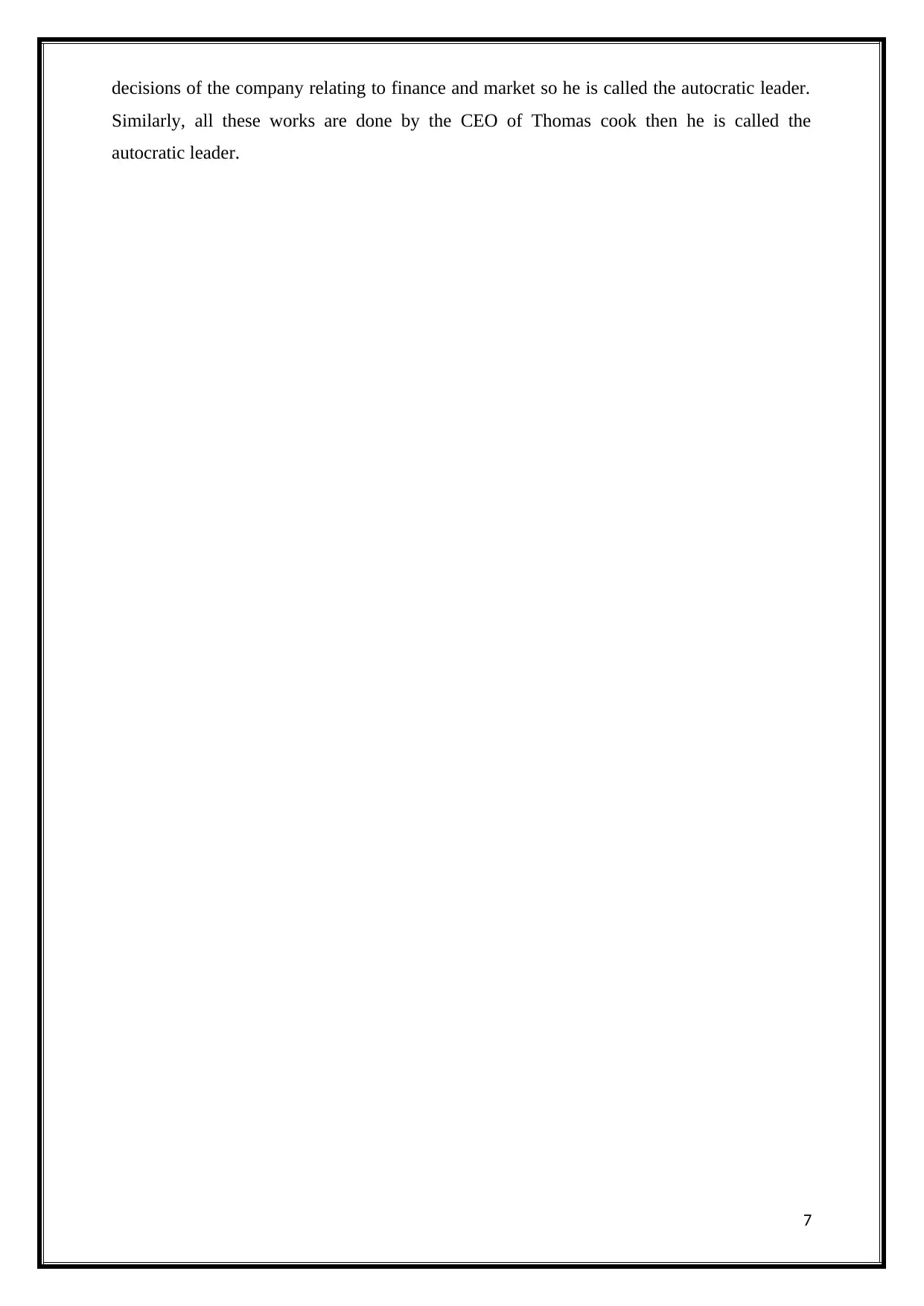
decisions of the company relating to finance and market so he is called the autocratic leader.
Similarly, all these works are done by the CEO of Thomas cook then he is called the
autocratic leader.
7
Similarly, all these works are done by the CEO of Thomas cook then he is called the
autocratic leader.
7
Paraphrase This Document
Need a fresh take? Get an instant paraphrase of this document with our AI Paraphraser
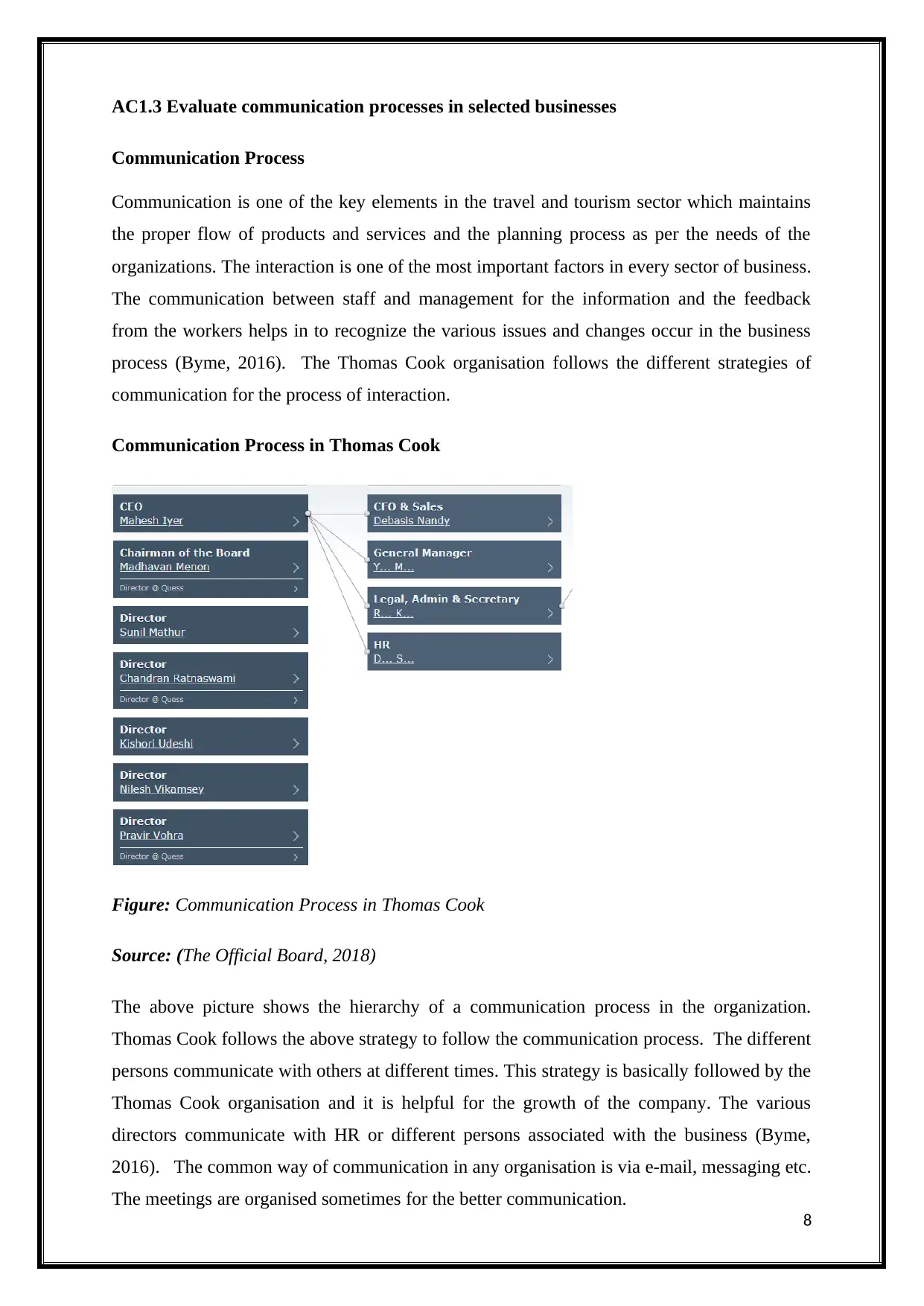
AC1.3 Evaluate communication processes in selected businesses
Communication Process
Communication is one of the key elements in the travel and tourism sector which maintains
the proper flow of products and services and the planning process as per the needs of the
organizations. The interaction is one of the most important factors in every sector of business.
The communication between staff and management for the information and the feedback
from the workers helps in to recognize the various issues and changes occur in the business
process (Byme, 2016). The Thomas Cook organisation follows the different strategies of
communication for the process of interaction.
Communication Process in Thomas Cook
Figure: Communication Process in Thomas Cook
Source: (The Official Board, 2018)
The above picture shows the hierarchy of a communication process in the organization.
Thomas Cook follows the above strategy to follow the communication process. The different
persons communicate with others at different times. This strategy is basically followed by the
Thomas Cook organisation and it is helpful for the growth of the company. The various
directors communicate with HR or different persons associated with the business (Byme,
2016). The common way of communication in any organisation is via e-mail, messaging etc.
The meetings are organised sometimes for the better communication.
8
Communication Process
Communication is one of the key elements in the travel and tourism sector which maintains
the proper flow of products and services and the planning process as per the needs of the
organizations. The interaction is one of the most important factors in every sector of business.
The communication between staff and management for the information and the feedback
from the workers helps in to recognize the various issues and changes occur in the business
process (Byme, 2016). The Thomas Cook organisation follows the different strategies of
communication for the process of interaction.
Communication Process in Thomas Cook
Figure: Communication Process in Thomas Cook
Source: (The Official Board, 2018)
The above picture shows the hierarchy of a communication process in the organization.
Thomas Cook follows the above strategy to follow the communication process. The different
persons communicate with others at different times. This strategy is basically followed by the
Thomas Cook organisation and it is helpful for the growth of the company. The various
directors communicate with HR or different persons associated with the business (Byme,
2016). The common way of communication in any organisation is via e-mail, messaging etc.
The meetings are organised sometimes for the better communication.
8

AC1.4 Analyse organisational culture and change in selected businesses.
Organisational Culture
The culture of an organisation is a vast area which required proper changes as per the
business organization. Thomas Cook is one of the largest organizations of UK which gives
the various services of tourism to the whole world. For the management, the various activities
and decision-making company has developed and implements the different type of
hierarchical structure for allotting the different resources and get the views of employees
about the resources. The organisational culture defines as the rules, values, visions, and the
language of a company which are followed by the employees.
The hierarchical structure is used to maintain the approach of professional strategy in the
products and services of the tourism industry. The culture of the company is according to the
places and the groups of the customer which helps to gain profit and the employees to talk
with the customers and managing the services of tourism (Atwood, 2018). The company has
to maintain a good environment for the employees and the customers. For example, the senior
employees of Thomas cook give the support to other employees and motivate them according
to the rules of the organization.
Changes in the business
To do some changes in the organization, there is a model which is used to change the systems
of the business. The organisational model of change is shown below:
9
Organisational Culture
The culture of an organisation is a vast area which required proper changes as per the
business organization. Thomas Cook is one of the largest organizations of UK which gives
the various services of tourism to the whole world. For the management, the various activities
and decision-making company has developed and implements the different type of
hierarchical structure for allotting the different resources and get the views of employees
about the resources. The organisational culture defines as the rules, values, visions, and the
language of a company which are followed by the employees.
The hierarchical structure is used to maintain the approach of professional strategy in the
products and services of the tourism industry. The culture of the company is according to the
places and the groups of the customer which helps to gain profit and the employees to talk
with the customers and managing the services of tourism (Atwood, 2018). The company has
to maintain a good environment for the employees and the customers. For example, the senior
employees of Thomas cook give the support to other employees and motivate them according
to the rules of the organization.
Changes in the business
To do some changes in the organization, there is a model which is used to change the systems
of the business. The organisational model of change is shown below:
9
⊘ This is a preview!⊘
Do you want full access?
Subscribe today to unlock all pages.

Trusted by 1+ million students worldwide
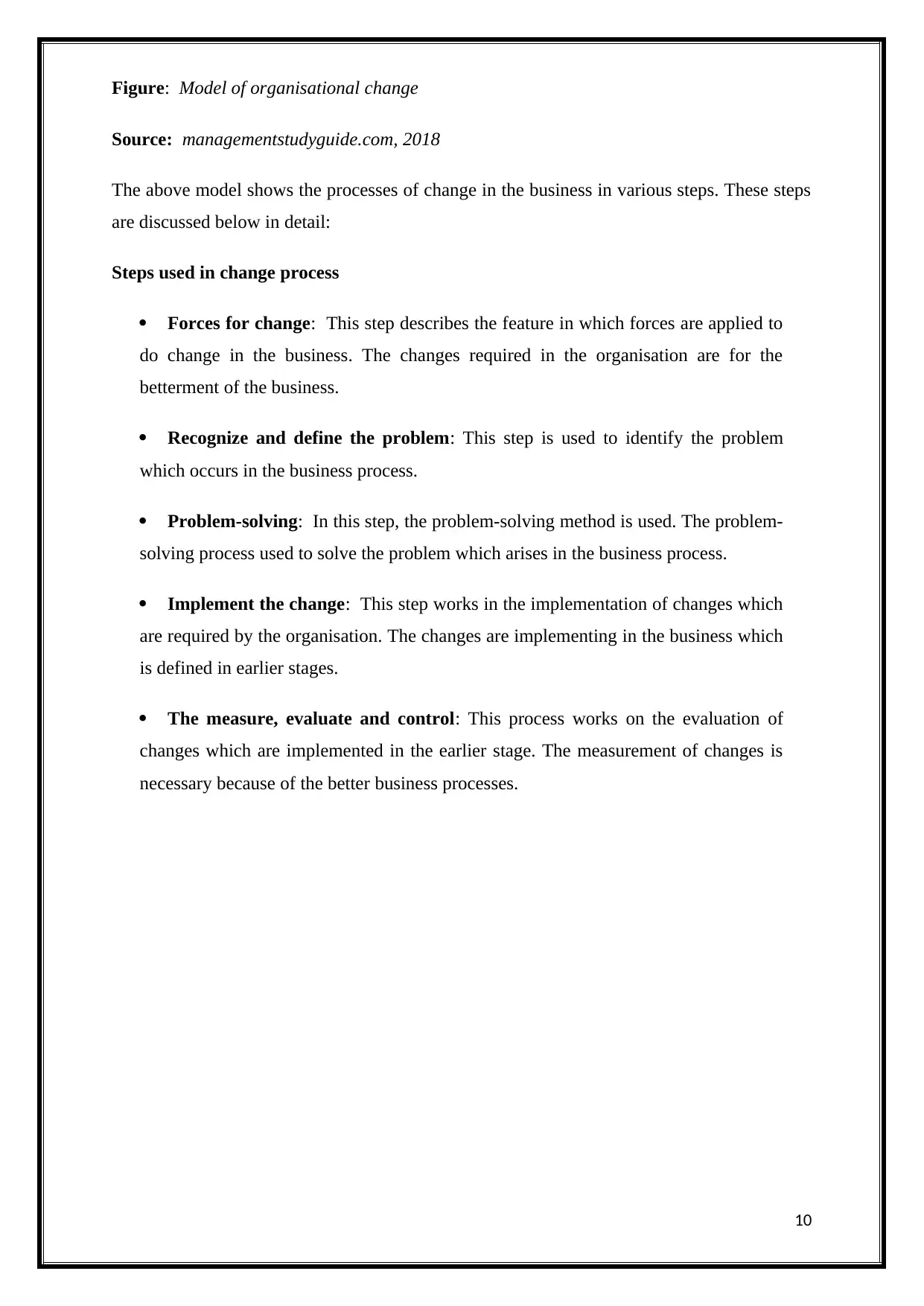
Figure: Model of organisational change
Source: managementstudyguide.com, 2018
The above model shows the processes of change in the business in various steps. These steps
are discussed below in detail:
Steps used in change process
Forces for change: This step describes the feature in which forces are applied to
do change in the business. The changes required in the organisation are for the
betterment of the business.
Recognize and define the problem: This step is used to identify the problem
which occurs in the business process.
Problem-solving: In this step, the problem-solving method is used. The problem-
solving process used to solve the problem which arises in the business process.
Implement the change: This step works in the implementation of changes which
are required by the organisation. The changes are implementing in the business which
is defined in earlier stages.
The measure, evaluate and control: This process works on the evaluation of
changes which are implemented in the earlier stage. The measurement of changes is
necessary because of the better business processes.
10
Source: managementstudyguide.com, 2018
The above model shows the processes of change in the business in various steps. These steps
are discussed below in detail:
Steps used in change process
Forces for change: This step describes the feature in which forces are applied to
do change in the business. The changes required in the organisation are for the
betterment of the business.
Recognize and define the problem: This step is used to identify the problem
which occurs in the business process.
Problem-solving: In this step, the problem-solving method is used. The problem-
solving process used to solve the problem which arises in the business process.
Implement the change: This step works in the implementation of changes which
are required by the organisation. The changes are implementing in the business which
is defined in earlier stages.
The measure, evaluate and control: This process works on the evaluation of
changes which are implemented in the earlier stage. The measurement of changes is
necessary because of the better business processes.
10
Paraphrase This Document
Need a fresh take? Get an instant paraphrase of this document with our AI Paraphraser
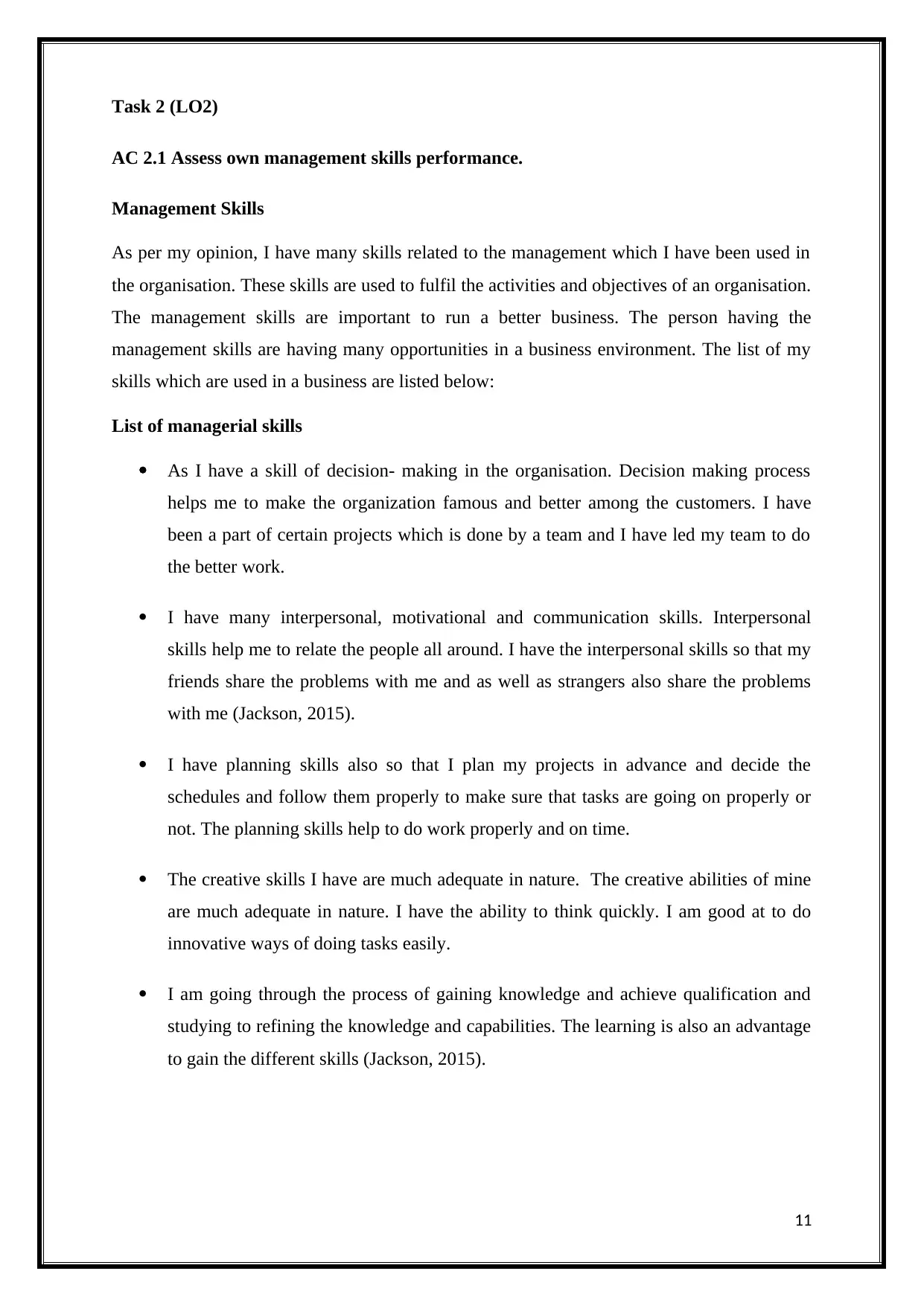
Task 2 (LO2)
AC 2.1 Assess own management skills performance.
Management Skills
As per my opinion, I have many skills related to the management which I have been used in
the organisation. These skills are used to fulfil the activities and objectives of an organisation.
The management skills are important to run a better business. The person having the
management skills are having many opportunities in a business environment. The list of my
skills which are used in a business are listed below:
List of managerial skills
As I have a skill of decision- making in the organisation. Decision making process
helps me to make the organization famous and better among the customers. I have
been a part of certain projects which is done by a team and I have led my team to do
the better work.
I have many interpersonal, motivational and communication skills. Interpersonal
skills help me to relate the people all around. I have the interpersonal skills so that my
friends share the problems with me and as well as strangers also share the problems
with me (Jackson, 2015).
I have planning skills also so that I plan my projects in advance and decide the
schedules and follow them properly to make sure that tasks are going on properly or
not. The planning skills help to do work properly and on time.
The creative skills I have are much adequate in nature. The creative abilities of mine
are much adequate in nature. I have the ability to think quickly. I am good at to do
innovative ways of doing tasks easily.
I am going through the process of gaining knowledge and achieve qualification and
studying to refining the knowledge and capabilities. The learning is also an advantage
to gain the different skills (Jackson, 2015).
11
AC 2.1 Assess own management skills performance.
Management Skills
As per my opinion, I have many skills related to the management which I have been used in
the organisation. These skills are used to fulfil the activities and objectives of an organisation.
The management skills are important to run a better business. The person having the
management skills are having many opportunities in a business environment. The list of my
skills which are used in a business are listed below:
List of managerial skills
As I have a skill of decision- making in the organisation. Decision making process
helps me to make the organization famous and better among the customers. I have
been a part of certain projects which is done by a team and I have led my team to do
the better work.
I have many interpersonal, motivational and communication skills. Interpersonal
skills help me to relate the people all around. I have the interpersonal skills so that my
friends share the problems with me and as well as strangers also share the problems
with me (Jackson, 2015).
I have planning skills also so that I plan my projects in advance and decide the
schedules and follow them properly to make sure that tasks are going on properly or
not. The planning skills help to do work properly and on time.
The creative skills I have are much adequate in nature. The creative abilities of mine
are much adequate in nature. I have the ability to think quickly. I am good at to do
innovative ways of doing tasks easily.
I am going through the process of gaining knowledge and achieve qualification and
studying to refining the knowledge and capabilities. The learning is also an advantage
to gain the different skills (Jackson, 2015).
11
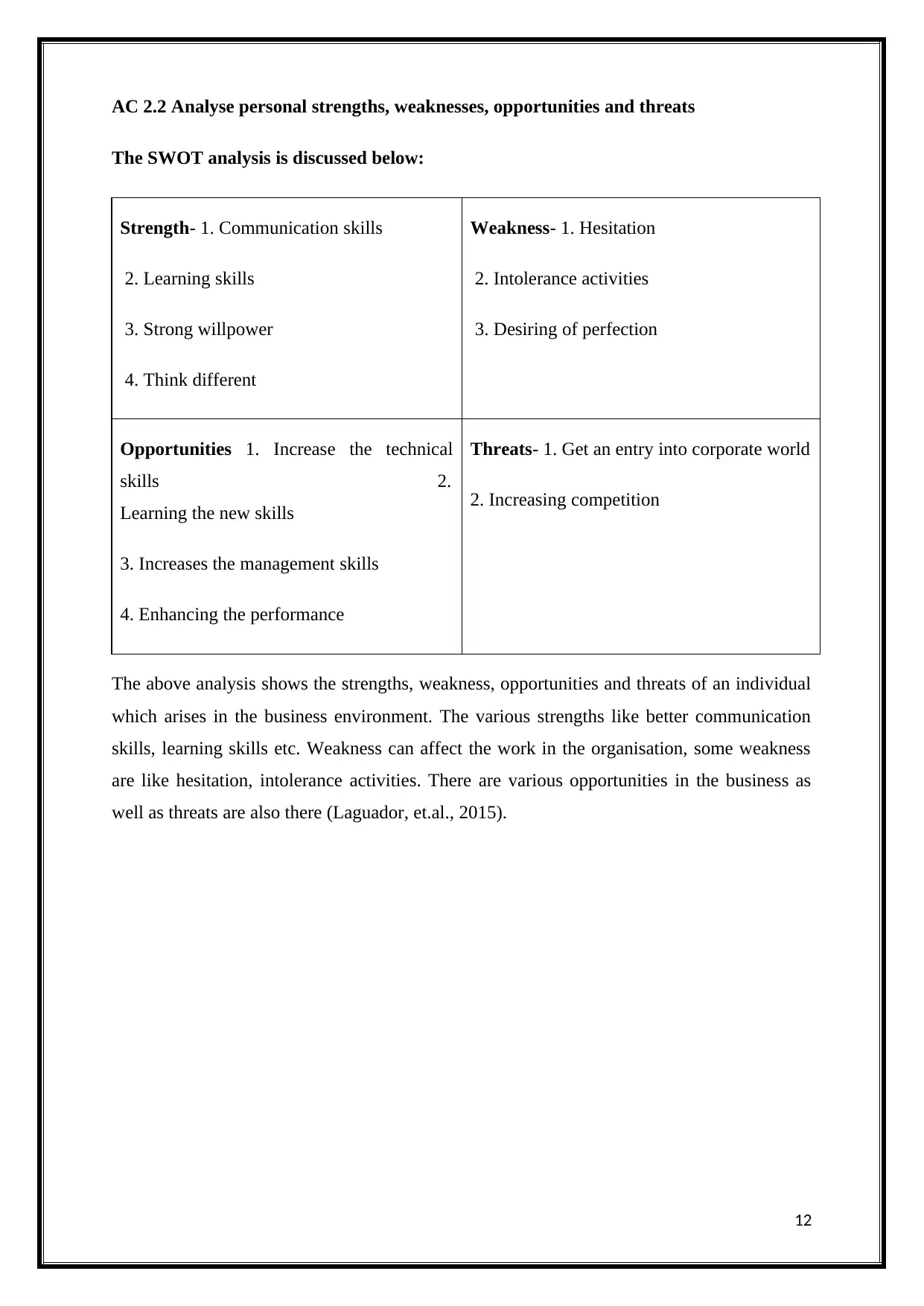
AC 2.2 Analyse personal strengths, weaknesses, opportunities and threats
The SWOT analysis is discussed below:
Strength- 1. Communication skills
2. Learning skills
3. Strong willpower
4. Think different
Weakness- 1. Hesitation
2. Intolerance activities
3. Desiring of perfection
Opportunities 1. Increase the technical
skills 2.
Learning the new skills
3. Increases the management skills
4. Enhancing the performance
Threats- 1. Get an entry into corporate world
2. Increasing competition
The above analysis shows the strengths, weakness, opportunities and threats of an individual
which arises in the business environment. The various strengths like better communication
skills, learning skills etc. Weakness can affect the work in the organisation, some weakness
are like hesitation, intolerance activities. There are various opportunities in the business as
well as threats are also there (Laguador, et.al., 2015).
12
The SWOT analysis is discussed below:
Strength- 1. Communication skills
2. Learning skills
3. Strong willpower
4. Think different
Weakness- 1. Hesitation
2. Intolerance activities
3. Desiring of perfection
Opportunities 1. Increase the technical
skills 2.
Learning the new skills
3. Increases the management skills
4. Enhancing the performance
Threats- 1. Get an entry into corporate world
2. Increasing competition
The above analysis shows the strengths, weakness, opportunities and threats of an individual
which arises in the business environment. The various strengths like better communication
skills, learning skills etc. Weakness can affect the work in the organisation, some weakness
are like hesitation, intolerance activities. There are various opportunities in the business as
well as threats are also there (Laguador, et.al., 2015).
12
⊘ This is a preview!⊘
Do you want full access?
Subscribe today to unlock all pages.

Trusted by 1+ million students worldwide
1 out of 24
Related Documents
Your All-in-One AI-Powered Toolkit for Academic Success.
+13062052269
info@desklib.com
Available 24*7 on WhatsApp / Email
![[object Object]](/_next/static/media/star-bottom.7253800d.svg)
Unlock your academic potential
Copyright © 2020–2025 A2Z Services. All Rights Reserved. Developed and managed by ZUCOL.




